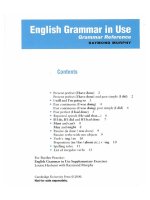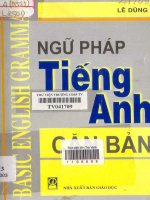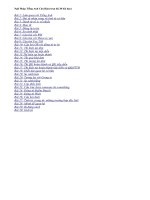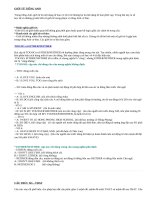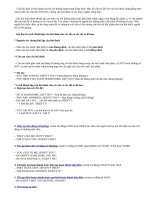Ngữ pháp tiếng anh căn bản dễ hiểu
Bạn đang xem bản rút gọn của tài liệu. Xem và tải ngay bản đầy đủ của tài liệu tại đây (1.47 MB, 151 trang )
TRUNG TÂM TUANTOEIC 990
ĐC: Số 8 ngách 178/40 Thái Hà, Hà Nội * ĐT: 04 6686 1084 | Hotline: 0966 89 0132 * Website: tuantoeic.com
NGỮ PHÁP TIẾNG ANH CĂN BẢN
Basic English Grammar
TuanToeic.com
4
What you’ll find in this book
1 Nouns 7–23
Common Nouns 7
Proper Nouns 8
Singular Nouns 11
Plural Nouns 11
Collective Nouns 17
Masculine and Feminine Nouns 20
The Possessive Form of Nouns 22
2 Pronouns 24–31
Personal Pronouns 24
Reflexive Pronouns 26
Possessive Pronouns 27
Demonstrative Pronouns 27
Interrogative Pronouns 28
Indefinite Pronouns 28
3 Adjectives 32–43
Kinds of Adjectives 32
The Order of Adjectives 33
Adjective Endings 35
Describing What Something Is Made of 37
The Comparison of Adjectives 39
Adjective Phrases 42
4 Determiners 44–51
The Articles 44
Using Nouns without Articles 45
Demonstrative Determiners 46
Quantifying Determiners 47
Interrogative Determiners 49
Possessive Determiners 49
Numbers 50
Using Determiners Together 50
TuanToeic.com
5
5 Verbs and Tenses 52–87
Subject and Verb Agreement 52
Transitive and Intransitive Verbs 55
The Simple Present Tense 58
am, is and are 59
there is and there are 60
The Present Progressive Tense 63
The Simple Past Tense 65
was and were 66
Irregular Verbs 67
The Past Progressive Tense 70
have, has and had 71
The Present Perfect Tense 73
Irregular Past Participles 73
The Future Tense 77
do, does and did 80
The Infinitive 83
The Imperative Form of Verbs 84
Gerunds 85
6 Auxiliary Verbs 88–94
can and could 88
will and would 89
shall and should 89
ought to 90
must 90
may and might 90
Verb Phrases 91
7 Adverbs and Adverb Phrases 95–100
Adverbs of Manner 95
Adverbs of Time 96
Adverbs of Place 96
Adverbs of Frequency 97
Adverbs of Duration 97
Adverbs of Emphasis 98
8 Prepositions and Prepositional Phrases 101–108
Preposition or Adverb? 101
Prepositions of Place 102
Prepositions of Time 102
Prepositions of Direction 103
Prepositions with Special Uses 103
Prepositions with Adjectives, Verbs or Nouns 105
TuanToeic.com
6
9 Conjunctions 109–117
and, but and or 109
Conjunctions Linking Phrases 110
Conjunctions with Lists 110
Conjunctions That Join Sentences 111
Other Words for and 111
Other Words for but 112
Other Words for or 112
Conjunctions of Time 113
Conjunctions of Place 113
Conjunctions of Reason 114
Conjunctions of Purpose 114
10 Sentences 118–133
Four Kinds of Sentence 118
Sentences with Objects 119
Verbs with Two Objects 120
Verbs with No Object 120
Simple Sentences 123
Compound Sentences 123
Conditional Sentences 124
Positive and Negative Sentences 124
Questions 128
Question Tags 130
11 Direct and Indirect Speech 134–139
Direct Speech 134
Indirect Speech 134
Indirect Commands 135
Indirect Questions 136
12 Punctuation 140–148
Punctuation Marks: period, comma, question mark,
exclamation point, apostrophe, quotation marks, colon 140
Capital Letter 144
A List of Irregular Verbs 149–152
TuanToeic.com
7
There are two main types of nouns: common nouns and proper nouns.
Common Nouns
Words for people, places and things are called common nouns.
These common nouns are words for things.
ruler chair hammer bicycle truth
pen table saw ship calculator
crayons sofa axe truck television
pencil loyalty drill ferry fridge
book lamp ladder train cooker
dictionary carpet lawnmower bus computer
courage telephone spade laziness printer
These common nouns are words for animals. Notice that special names for
young animals are included.
animal its young
dog puppy
cat kitten
cow calf
horse foal
sheep lamb
goat kid
frog tadpole
These common nouns are words for places.
bank airport
hotel gas station
library park
museum farm
mall zoo
theater factory
hospital nursery
animal its young
fox cub
elephant calf
kangaroo joey
bear cub
lion cub
tiger cub
whale calf
school post office
university police station
office restaurant
mosque supermarket
temple stadium
shop synagogue
gym church
1 Nouns
1 Nouns
◗
◗
◗
TuanToeic.com
8
These common nouns are words for people who do certain things.
singer manager sailor gardener
dancer secretary pilot police officer
artist teacher driver plumber
photographer doctor writer farmer
magician dentist friend clerk
athlete lawyer brother technician
Proper Nouns
The names of particular people, places and things are proper nouns. They
always begin with a capital letter.
These people’s names are proper nouns.
Robin Hood Florence Nightingale Mom Miss Park
Aladdin Muhammad Ali Dad Mrs. Taylor
Frankenstein George Washington Granny Mr. Young
Harry Potter David Beckham Grandad Dr. Lee
Santa Claus Julia Roberts Uncle David Professor Raj
Mahatma Gandhi Nelson Mandela Aunt Diana Jose
Confucius Alex Rodriguez Ms. Hall Yang Ming
The names of the days of the week and the months of the year are proper
nouns.
days of the week months
Monday January July
Tuesday February August
Wednesday March September
Thursday April October
Friday May November
Saturday June December
Sunday
◗
◗
◗
Nouns: Proper Nouns
AUGUST
Sunday
4 11 18 25
Monday
5 12 19 26
Tuesday
6 13 20 27
Wednesday
7 14 21 28
Thursday
1 8 15 22 29
Friday
2 9 16 23 30
Saturday
3 10 17 24 31
TuanToeic.com
9
Nouns: Proper Nouns
The names of special days and celebrations are also proper nouns.
New Year’s Day Veterans' Day
Mother’s Day Thanksgiving
Independence Day Memorial Day
Valentine’s Day Halloween
Labor Day Christmas
Ramadan Yom Kippur
The names of famous places, buildings and monuments are proper nouns.
Big Ben the Empire State Building
the Sphinx the Taj Mahal
Graceland the Eiffel Tower
the Grand Canyon the Golden Gate Bridge
the Sydney Opera House the Great Wall of China
Buckingham Palace Chaco Canyon Pueblo
the Leaning Tower of Pisa the Statue of Liberty
The names of people who live in a particular country are also proper
nouns.
country people
Afghanistan Afghans
Australia Australians
Britain the British
China the Chinese
France the French
Germany Germans
India Indians
Indonesia Indonesians
Italy Italians
Japan the Japanese
Korea Koreans
Malaysia Malaysians
◗
country people
Samoa Samoans
New Zealand New Zealanders
Pakistan Pakistanis
the Philippines Filipinos
Russia Russians
Nicaragua Nicaraguans
South Africa South Africans
Spain Spaniards
Switzerland the Swiss
Thailand Thais
USA Americans
Vietnam the Vietnamese
◗
◗
TuanToeic.com
10
Exercise 1
Write each common noun under the correct heading.
theater lion father brother
doctor restaurant builder stove
elephant kangaroo museum library
things animals places people
Exercise 2
Underline the common nouns and circle the proper nouns in these sentences.
1. I told Uncle John about my accident.
2. Kim and Stephanie wore masks on Halloween.
3. The lawnmower is broken.
4. We’re going to the movies tomorrow.
5. The lion is playing with one of its cubs.
6. My sister’s favorite soccer player is David Beckham.
7. I’m watching a videotape about the Sahara Desert.
8. The tourists visited Rome and saw the Colosseum.
9. Does this bus go to the stadium?
10. We’re reading a story about a boy called Harry Potter.
Exercise 3
Read the following passage containing common nouns and proper nouns. Put a C in
the box after a common noun and a P in the box after a proper noun.
Mr. Peters
lives in Maine in a big house by the sea . He has three cats
and a dog
. He likes to travel to different countries . Last Christmas , he went
to Paris
and saw the Eiffel Tower . He enjoyed eating French food in nice
restaurants
.
10
TuanToeic.com
11
Nouns: Singular Nouns; Plural Nouns
Singular Nouns
Nouns can be singular or plural.
When you are talking about just one thing or person, use a singular noun.
For example:
a tent a park an idea
a taxi a doctor an oven
a house a lady an exercise
Plural Nouns
Use a plural noun when you are talking about two or more people, places or
things.
Just add s to make most nouns plural.
singular plural
a computer computers
a chair chairs
a train trains
a player players
a teacher teachers
a taxi taxis
N o t e s
n Words called articles or determiners are used to signal nouns.
a river an armchair three biscuits
a castle an idea five eggs
n The article an is used before nouns that begin with the vowels a, e, i, o and u.
an artist an eye an insect
an oven an umbrella
n The article a is used before nouns that begin with the other letters, called consonants.
But some words don’t follow these rules.
• a uniform, a unit, a user: a, not an, is used because the vowel u in these words is
pronounced like the word you;
• an hour, an heir, an honor: an, not a, is used because the consonant h in these words
is not pronounced.
singular plural
a mountain mountains
a river rivers
an envelope envelopes
an insect insects
an oven ovens
an uncle uncles
◗
TuanToeic.com
12
singular plural
sandwich sandwiches
witch witches
brush brushes
flash flashes
box boxes
fox foxes
singular plural
day days
tray trays
runway runways
chimney chimneys
trolley trolleys
valley valleys
Nouns that end in s, ss, ch, sh or x, are made plural by adding es.
singular plural
bus buses
glass glasses
dress dresses
branch branches
church churches
beach beaches
Most nouns that end in y are made plural by changing the y to i and
adding es.
singular plural
baby babies
family families
story stories
teddy teddies
fairy fairies
puppy puppies
housefly houseflies
library libraries
city cities
lily lilies
party parties
dictionary dictionaries
Nouns that have a vowel before the y are made plural by simply adding s at
the end.
singular plural
key keys
monkey monkeys
donkey donkeys
toy toys
boy boys
cowboy cowboys
◗
◗
◗
Nouns: Plural Nouns
TuanToeic.com
13
Many nouns that end in f are made plural by changing the f to v and
adding es.
singular plural
half halves
leaf leaves
shelf shelves
wolf wolves
thief thieves
But some nouns that end in f
are made plural simply by
adding s.
singular plural
chief chiefs
roof roofs
handkerchief handkerchiefs
cliff cliffs
puff puffs
Some nouns that end in f can be
made plural in two ways.
singular plural
scarf scarfs or scarves
hoof hoofs or hooves
dwarf dwarfs or dwarves
wharf wharfs or wharves
Most nouns that end in fe are made plural by changing the f to v and
adding s.
singular plural
knife knives
wife wives
life lives
midwife midwives
◗
◗
◗
Nouns: Plural Nouns
TuanToeic.com
14
Most nouns that end in o are made plural by adding s.
singular plural
video videos
hippo hippos
zoo zoos
kangaroo kangaroos
But other nouns that end in o are
made plural by adding es.
singular plural
tomato tomatoes
potato potatoes
hero heroes
Some nouns change spelling from the singular form to the plural.
singular plural
man men
woman women
child children
person people
mouse mice
tooth teeth
foot feet
goose geese
The plural form of some nouns is the same as the singular form.
singular plural
sheep sheep (not sheeps)
deer deer (
not deers)
fish fish (
not fishes)
aircraft aircraft (
not aircrafts)
salmon salmon (
not salmons)
◗
◗
N o t e s
N o t e s
When you are talking about different
kinds of fish, the plural can be fishes,
for example:
the various fishes of the Indian Ocean
◗
What's the plural of the kind
of mouse that you use with a
computer? The plural is either
mice or mouses.
Nouns: Plural Nouns
TuanToeic.com
15
Some nouns are always plural.
trousers glasses
shorts spectacles
jeans goggles
pants scissors
tights binoculars
pajamas pliers
Some nouns are usually plural.
shoes chopsticks
sandals gloves
slippers clogs
boots socks
Exercise 4
Underline all the nouns in the following sentences. Are they common or proper nouns?
Put a checkmark in the correct box.
common nouns proper nouns
1. Do you like cheese?
2. They stood next to the Niagara Falls.
3. May I borrow your umbrella?
4. The ambulance was driving very fast.
5. Carl did not agree with them.
6. She loves to visit Disneyland.
7. Would you like some more water?
8. The fog was very thick.
9. May I invite Tom to join us?
10. My car is very old.
N o t e s
✓
You can use a pair of with these
plural nouns. For example:
a pair of trousers
a pair of pants
a pair of glasses
a pair of scissors
a pair of chopsticks
a pair of sandals
a pair of gloves
Nouns: Plural Nouns
◗
15
TuanToeic.com
16
Exercise 5
Read the following passage. Write S in the box after each singular noun and P in the
box after each plural noun.
Our teacher is a very nice lady . She’s very kind to all the children in the
class and she tells us very funny stories . Yesterday, she told a story about
the animals on a farm . They all had a race . The pigs and sheep ran
faster than the ducks and cows , but the heroes of the story were the
mice . They were faster than all the other animals , even though they had the
shortest legs !
Exercise 6
Read the following passage. Notice that the plural nouns are missing. Write the correct
plural form of the singular nouns in parentheses. The first one has been done for you.
Three
(lady) in pink (dress) took their (baby)
for a walk in the zoo. They saw four (giraffe), three (hippo),
two (kangaroo) and an elephant. They walked for so long that their
(foot) became sore, so they sat down on a bench for a rest near some
(monkey). The (monkey) were playing with cardboard
(box) and throwing (stick) at each other. After a while, the
(lady) looked at their (watch) and decided it was time to go
home.
ladies
16
TuanToeic.com
17
N o t e s
Collective Nouns
Words for groups of people, animals or things are called collective nouns.
Here are some collective nouns for
groups of people.
a family a crew
a team a club
a community a committee
a choir a company
a band a gang
an orchestra the government
an audience the army
Collective nouns may be used with a singular verb or with a plural verb. If
the group is acting as a single unit, use a singular verb. If group members are
acting as individuals, use a plural
verb. For example:
The crowd was orderly.
or
The crowd were clapping, yelling
and cheering.
Here are more collective nouns you can use for groups of people.
a crowd of shoppers a gang of thieves
a
company of actors a panel of judges
a
class of schoolchildren a platoon of soldiers
Many groups of animals have their own special collective nouns.
a herd of cattle a pack of wolves a litter of puppies
a flock of birds a
pride of lions a troop of monkeys
a drove of sheep a
pod of dolphins a brood of chickens
a
gaggle of geese a school of fish a swarm of bees
Always use a plural verb with the
collective nouns, people and the
police. For example:
Those people live (not lives) in Asia.
The police have caught (
not has
caught) the thief.
◗
◗
◗
◗
Nouns: Collective Nouns
TuanToeic.com
18
Some groups of things also have their own special collective nouns.
a bunch of bananas a deck of cards
a
cluster of grapes a flight of steps
a
bunch of flowers a suite of rooms
a
bouquet of flowers a suite of furniture
a
range of mountains a set of tools
a
fleet of ships a string of beads
a
fleet of vehicles a grove of trees
Some nouns name the amount or form of something.
a loaf of bread a bar of soap
a
ball of string a bar of chocolate
The words a piece of mean a single serving or part of something.
a slice/piece of bread a slice/piece of cheese
a
piece/square of chocolate a slice/piece of cake
a
sheet/piece of paper a piece of chalk
a
piece of information a piece of advice
Exercise 7
Read the following passage. Write the missing collective nouns in the blank spaces.
Remember that sometimes there are two words you can use.
Mom took Kate, Rudy and Derrick to the zoo. The zoo was very busy. A
of people had gathered round the monkeys. One of the monkeys had a
of bananas. Watching the monkey eat made the children feel hungry. Mom took a
of bread and some of cheese out of the picnic hamper
and everyone made sandwiches. After eating the sandwiches, the children had two
of chocolate each. Rudy wanted to give one piece to a monkey, but the
zookeeper gave Rudy a very useful
of advice. “Monkeys may look friendly,
but sometimes they are very fierce,” he said.
◗
◗
◗
18
Nouns: Collective Nouns
TuanToeic.com
19
Exercise 8
Read the sentences. Does the collective noun indicate a group acting together as a
single unit? If so, circle the singular verb. Does the collective noun indicate a group in
which each member acts individually? Circle the plural noun.
1. The jury (were/was) arguing about the importance of evidence.
2. A whole company of soldiers (is/are) marching in the parade.
3. A gaggle of geese (is/are) running every which way in the barnyard.
4. Those people (live/lives) in North America.
5. The police (has/have) arrested the suspect.
6. That troupe of actors always (stay/stays) at the Grand Hotel.
7. The committee (is/are) handing in their ballots.
8. Our school band (play/plays) many lively marches.
9. A big colony of ants (lives/live) under the front porch.
10. The government (are/is) entitled to collect taxes.
Exercise 9
Complete each phrase with a noun from the box that names a part or an amount of
something.
bushel scoop ream pair
drop grain pinch galaxy
1. a of stars 5. a of potatoes
2. a of sand 6. a of bookends
3. a of paper 7. a of ice cream
4. a of salt 8. a of rain
19
TuanToeic.com
20
masculine feminine
nephew niece
king queen
prince princess
emperor empress
wizard witch
actor actress
policeman policewoman
waiter waitress
◗
◗
◗
Nouns: Masculine and Feminine Nouns
Masculine and Feminine Nouns
Masculine nouns are words for men, boys and male animals.
Feminine nouns are words for women, girls and female animals.
masculine feminine
boy girl
man woman
father mother
son daughter
brother sister
husband wife
grandfather grandmother
uncle aunt
Many nouns are used for both males and females. They are called common
gender nouns.
teacher baby doctor scientist
pupil parent astronaut president
child cousin dancer manager
With animals, there is one general word for the animal and special words
for the male and the female. Sometimes the word for the male animal is the
same as the general word. Sometimes the word for the female animal is the
same as the general word.
animal masculine feminine
rabbit buck doe
horse stallion mare
sheep ram ewe
pig boar sow
chicken rooster hen
duck drake duck
cattle bull cow
goose gander goose
fox fox vixen
tiger tiger tigress
lion lion lioness
TuanToeic.com
21
Exercise 10
Complete the crossword puzzle with the correct masculine or feminine nouns.
A C R O S S
masculine feminine
3. bull
5. man
6. fox
9.
princess
10.
empress
12. stallion
13. brother
14. king
15.
duck
16.
witch
D O W N
masculine feminine
1. actress
2. waiter
4. husband
7. nephew
8. aunt
11.
goose
1 2
3 4 5
6 7
8
9 10
11
12 13
14
15
16
21
TuanToeic.com
22
◗
The Possessive Form of Nouns
Use the possessive form of a noun to show ownership.
To make the possessive form, put an
apostrophe and an s ’s after a
singular noun.
This is my bed and that is Peter’s bed.
We all like
Dad’s cooking.
It is my job to collect
everybody’s plate after the meal.
The flies are buzzing around the
horse’s tail.
This is Susan and Jenny’s room.
This is
Tom’s hat and that is Tom’s father’s hat.
After plural nouns that don’t end in s, use an apostrophe and an s ’s to
make the possessive form.
The children’s room is always messy.
Some
people’s houses are bigger than ours.
Rats’ tails are longer than
mice’s tails.
Men’s voices are deeper than women’s voices.
N o t e s
■ How do you make the possessive form when two names linked
by and are the owners? Put an ’s after the second name only. For
example:
Katy and Mike’s house is very big. (= the house that belongs to both
Katy and Mike)
Joe and Sarah’s dad works at the shoe factory. (= He is Joe’s dad and
he is also Sarah’s dad.)
■ Sometimes two possessive forms with ’s appear together, one after
the other:
This is John’s brother’s ball. (= The ball belongs to John’s brother.)
Paul’s teacher’s house has a swimming pool. (= the house that
belongs to Paul’s teacher)
Nouns: The Possessive Form of Nouns
◗
TuanToeic.com
23
N o t e s
◗
Tom’s
After plural nouns that end in s, just add an apostrophe s’ .
The pupils’ desks are arranged in rows.
The
boys’ bedroom is bigger than the girls’ bedroom.
The strong winds destroyed all the
farmers’ crops.
Mice’s tails are shorter than
rats’ tails.
Exercise 11
Read the following passage. The possessive nouns are missing. Write the correct
possessive form of the nouns in parentheses. The first one has been done for you.
Peter is spending the day at
(Tom) house. Peter likes Tom’s family. He
especially likes
(Tom’s mom) cooking! The boys play lots of games
together.
(Tom) sister doesn’t like (Tom and Peter) games.
She is playing by herself. Sometimes the
(boys) games become so noisy
that Mom tells them to go and play in the garden.
(Tom) dog is in the
garden, lying in the sunshine. Tom wants to play with the dog, but Peter is afraid of the
(dog) big teeth and sharp claws.
At 7 o’clock,
(Peter) dad arrives in his car to take Peter home. Tom says he
likes
(Peter’s dad) new car. (Peter) dad says that
he’ll take Tom for a ride in it sometime.
When a name ends in s, you can make the possessive form in
either of two ways: add an apostrophe and an s ’s , or add
just an apostrophe ’ . For example:
This is James’s house. or This is James’ house.
Which is
Charles’s bike? or Which is Charles’ bike?
23
Nouns: The Possessive Form of Nouns
TuanToeic.com
24
2 Pronouns
2 Pronouns
A pronoun is a word that takes the place of a noun. There are different kinds
of pronouns.
Personal Pronouns
Personal pronouns may be used as:
n the subject of a verb, or
n the object of a verb.
Subject Pronouns
The subject of a verb does the action of the verb. The personal pronouns
I, you, he, she, it, we and they can all be used as the subject of a verb. Study
the following two sentences:
Lisa likes cats. She has four cats.
In the first sentence, the proper noun Lisa is the subject of the verb likes.
In the second sentence, the pronoun she is the subject of the verb has.
Here are some more pairs of sentences that show personal pronouns used
as subjects of verbs.
My name is Michael. I am fourteen.
My father works hard. He works in a factory.
My sister is older than me. She is twelve.
Our dog is very naughty. It likes to chase cats.
Bob, you are a bad dog!
David and I are playing football. We like sports.
Jim and Jeff are my brothers. They are older than I am.
◗
TuanToeic.com
25
Object Pronouns
The object of a verb receives the action of the verb. The personal pronouns
me, you, him, her, it, us and them can all be used as the object of a verb.
Look at the following two sentences:
Lisa likes cats. She likes to stroke them.
In the first sentence, the noun cats is the object of the verb likes. In the
second sentence, the pronoun them is the object of the verb stroke.
Here are some more pairs of sentences that show personal pronouns
used as objects of verbs.
I’m doing my homework. Dad is helping me.
Goodbye, children! I’ll call you later.
Where is John? I need to speak to him.
Miss Garcia is very nice. All the children like her.
The car is very dirty. Mom is cleaning it.
Uncle Harry called Mary to ask her a question.
My chocolates are all gone. Someone has eaten them.
First Person, Second Person and Third Person
In grammar, the person who is speaking is called the first person. The one
spoken to is called the second person, and the one spoken about is called the
third person.
Here is a table to help you remember which pronouns to use.
subject object
first person singular I me
second person singular you you
third person singular he him
she her
it it
first person plural we us
second person plural you you
third person plural they them
◗
Pronouns: Personal Pronouns
TuanToeic.com
26
Reflexive Pronouns
Reflexive pronouns are words that refer to the noun or pronoun that is
the subject of the verb. The words myself, yourself, himself, herself, itself,
ourselves, yourselves and themselves are reflexive pronouns.
My brother built this computer himself.
Be careful not to cut yourself with that knife.
John was looking at himself in the mirror.
Kate fell and hurt herself.
Our cat washes itself after every meal.
We baked the cake by ourselves.
Come in, everybody, and find yourselves a seat.
The children cleaned their room all by themselves.
Bears like to rub themselves against a tree.
The bird washed itself by splashing in a puddle.
The players train every day to keep themselves fit.
Have yourselves a good time.
Here is a table to help you remember which reflexive pronoun to use with
which personal pronoun.
singular personal reflexive plural personal reflexive
pronoun pronoun pronoun pronoun
I (subject pronoun) myself we (subject pronoun) ourselves
me (object pronoun) myself us(object pronoun) ourselves
you (subject/object yourself you (subject/object yourselves
pronoun) pronoun)
he (subject pronoun) himself they (subject pronoun) themselves
him (object pronoun) himself them (object pronoun) themselves
she (subject pronoun) herself
her (object pronoun) herself
it itself
Pronouns: Reflexive Pronouns
TuanToeic.com
27
Possessive Pronouns
Possessive pronouns are used to talk about things that belong to people.
The words mine, yours, his, hers, ours and theirs are possessive pronouns.
This book is mine.
Have you lost yours, Tom?
This pen is mine and that one is his.
Sarah has lost her cat. Is this cat hers?
I can see our car, but where is yours?
We’ve had our lunch, but they haven’t had theirs.
Here is a table to help you remember which possessive pronoun to use with
which personal pronoun.
singular personal possessive plural personal possessive
pronoun pronoun pronoun pronoun
I, me mine we, us ours
you yours you yours
he, him his they, them theirs
she, her hers
Demonstrative Pronouns
Demonstrative pronouns are used for pointing out things. The words this,
that, these and those are demonstrative pronouns.
This is my desk. These are my pets.
This is the Mings' house. These are sheep but those are goats.
That is my friend’s house. Those are horses.
That’s
my mother’s car.
You’ll have to work harder than this.
We can do better than that.
It’s raining again. This is awful!
Who is that knocking at the door?
Hi, Kathleen. This is Michael.
N o t e s
n Use this and these when you are
talking about things near you.
n Use that and those when you are
talking about things farther away.
Pronouns: Possessive Pronouns; Demonstrative Pronouns


